Gas pressure relief valve: types of devices + selection guidelines
The operating parameters of gas fuel in the system are regulated using various devices, among which the gas pressure relief valve is considered the simplest and at the same time effective. This device is required for installation both in gas pipelines and in a local home network.
If your home has a gas boiler or stove, we suggest that you become more familiar with the PSK - safety relief valve, so that you can use it if necessary.
The content of the article:
Purpose of the gas valve
PSK is a safety valve element responsible for the safety of the gas pipeline and gas equipment connected to it. During operation, the valve is in a closed position, therefore it is classified as a closed pipe fitting.
Such devices are installed not only on gas pipelines, they are an integral part of other communications - water supply, heating network. Everywhere they perform the same function - they stabilize the pressure in the network, provide the operating parameters necessary for the proper functioning of the system.
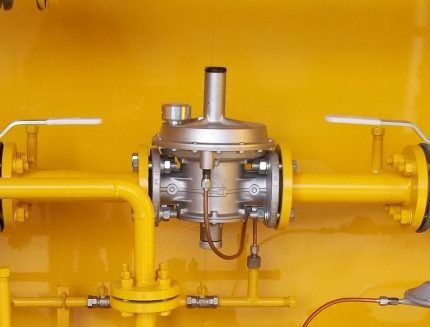
The pressure surge is usually short-lived and depends on a number of factors.
Reasons that can cause excess pressure in the system:
- breakdown of connected gas equipment – double-circuit boiler, instantaneous water heater or capacitive boiler, shut-off valves;
- use of fuel of inappropriate composition;
- change in temperature indicators in the pipeline;
- failure in the thermal-mechanical circuit.
The installation location of the gas safety valve is standard, depending on the efficiency of the application: either in the pressure regulator, or immediately behind it. After automatic operation of the valve, it returns to its operating – closed state.
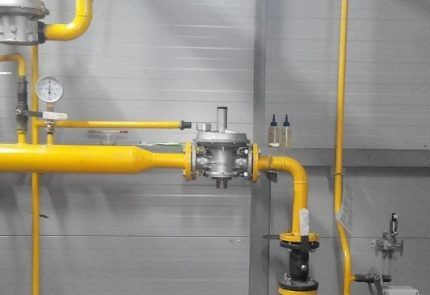
What are the consequences of the absence of a PSK on the network? The most common consequences are mechanical destruction of the pipeline or breakdown of connected equipment, which can cause a gas leak.
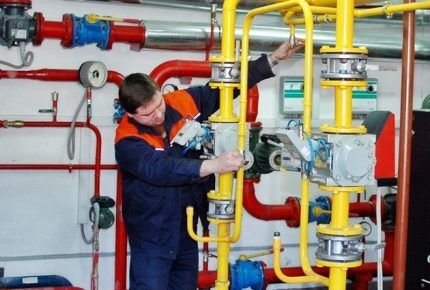
Along with relief devices, gas safety shut-off valves are also used, with the help of which the fuel supply is shut off. This happens automatically. The shut-off valve element is installed on the pipeline, in the gap between the filter and the pressure regulator.
The operating limit of the SPD is indicated in the technical data sheet of the device. The upper critical parameter is usually equal to the formula: slave. pressure +25%.
Design features and sizes
PSK cannot be manufactured in a handicraft way; products are produced in factory conditions in accordance with the requirements of GOST or TU.
The material must be durable, wear-resistant, not prone to deformation from changes in operating conditions, and not susceptible to the negative effects of corrosion. Most often it is brass or aluminum, but devices are also made from cast iron and stainless steel.

There are two threaded holes in the housing. Their diameter depends on the type of PSC and is usually 1″ or 2″. For household networks, mainly two types of valves are used, differing in cross-section - 25 mm or 50 mm.

The principle of operation of the protective gas valve is simple: as soon as excess gas enters the device and begins to put pressure on the membrane, it acts on the spring, which opens the outlet to the outside. As soon as the pressure drops to operating parameters, the spring closes the hole.
Although the devices operate automatically, they are equipped with a forced opening mechanism. This is necessary to check the performance of the valve.
To perform testing, you need to pull a special element of the device - the rod. This manipulation should be repeated several times to make sure that the mechanism works.
The shut-off and control valve is mounted in tandem with the valve so that, if necessary, if the valve suddenly does not work, the gas supply can be quickly shut off.
Types of trigger safety devices
The classification of PSK is based on design features and functions. There are two main groups that differ in the design of the working mechanism - membrane and spring, and two varieties that act differently at the moment of increase pressure in the gas pipeline – low-lift and full-lift.
Let's look at what their differences are and what you need to know about the operation of various valves.
Classification #1 – membrane and spring
Membranes are named after one of the main working elements - the membrane. It is installed inside the housing and is responsible for releasing excess gas when pressure increases. This is a sensitive part, and one of its main qualities is elasticity. If the required flexibility is lost, the element needs to be replaced.
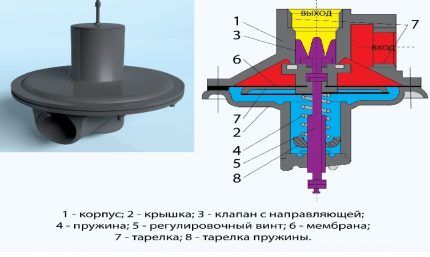
It is membrane, more sensitive PSCs that are installed in gas systems with low pressure - that is, in household networks as well.
For the diaphragm valve to operate, the pressure in the system must increase by 15%.
Spring-loaded valves are distinguished by the fact that the main operating element is a spool controlled by a spring. It simultaneously performs the functions of both a sensitive and a shut-off part.
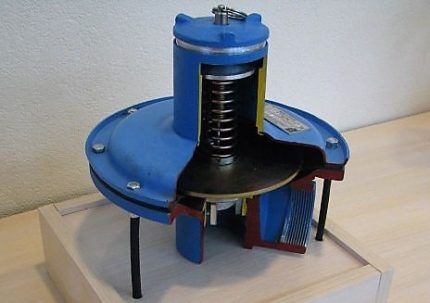
Blowing is a technical procedure that prevents the spool from “sticking” in the seat, and also performs cleaning functions. By purging, seals last longer.
Classification #2 – low-lift and full-lift
The difference between the valves is expressed in the method and speed of opening the shutter. For low-lift devices it opens gradually, depending on the degree of increase in pressure in the network, while for full-lift devices it opens sharply, jerkily, to the full width.
The second type of valve closes accordingly - quickly, simultaneously. As soon as the pressure drops, the spool immediately hits the seat.
If the first type can have several opening positions, then the second has only two: “closed” and “open”. Another difference between low-lift PSKs is their low throughput.
Advantages and disadvantages of PSK
Regardless of the design features or operating principle, all types of relief valves have advantages due to which they are actively used for gas communications equipment.
Here are the main ones:
Most of the models are universal - they can be used not only for gas pipeline equipment, but also for heating system installation, water supply, communications for moving steam.
The shock-absorbing function is performed by elastic seals; they are also responsible for sealing the connections between the fittings and the pipes. The average service life of seals is 5 years, after which replacement is required.
All PSKs are designed for increased loads and exposure to aggressive substances; however, they require maintenance and regular inspection.
The only disadvantages include the need for additional installation work, but this is eliminated if the PSK is integrated into the regulator.
Requirements for choosing a PSK
Before installing gas communications, a package of documents is prepared that details the requirements for all parts of the pipeline, including the discharge valves.
The main requirements include the following:
- the valve shutter must open as much as possible at the pressure established in accordance with the standards;
- the valve is closed automatically only after adjusting the pressure to the operating condition (or below the operating parameters by 5%);
- when closed, the valve must ensure 100% tightness of the network.
If one of the requirements is violated, the pressure in the network will decrease or increase to critical levels, as a result of which the operation of the system will be disrupted.
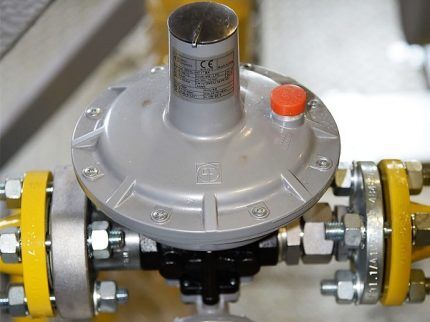
In order for the device to perform its functions and not fail prematurely, it is necessary not only to choose a model that matches the characteristics, but also to install it correctly, and then strictly follow the operating rules.
Some useful tips:
- To adjust the PSC, you will need a flow meter (pressure gauge), which is usually installed next to the valve.
- The device cap is always directed upward, as are the gas outlet pipes, if they are present in the system.
- The movement of the gas flow must correspond to the arrow marked on the valve body.
- Shut-off valves are not installed between the PSK and the gas source.
- It is necessary to ensure that all safety devices are clean and in good working order.
- Adjustment of operating parameters should only be carried out by a gas service representative.
We remind you that for the correct functioning of all safety parts, both equipment and fuel must meet the requirements of regulatory documentation.
For example, GOST 5542-2014 specifies the characteristics of the working medium - natural gas, GOST 9544-2015 - requirements for fittings, GOST 15150-69 - for the climatic environment, GOST 6357-81 - for threads, GOST 33259-2015 - to the flanges.
Conclusions and useful video on the topic
What PSK-50 looks like:
Replacement of PSK and PZK - universal gas regulator:
Design features and assembly of the safety valve:
When installing a gas pipeline and connecting household appliances, do not neglect the installation of a set of safety valves.A properly selected relief valve is responsible for regulating the pressure in the gas system - which means that it will work properly, and the residents of the house can rest assured about their safety.
But do not forget that Gorgaz or Oblgaz is responsible for the installation and maintenance of gas equipment, so do not rely only on yourself and call the gas workers on time.
Please leave comments, ask questions, post photos related to the topic of the article in the block below. Tell us about how you selected and installed a safety valve in the heating system of your own house or apartment. Share useful information that may be useful to site visitors.



